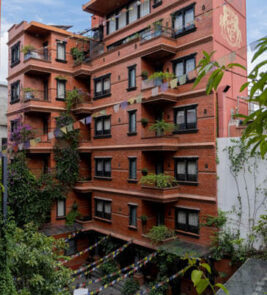Dal-Bhaat-Tarakari is the heart of every Nepali. This local comfort food is cooked in almost every household two times a day. Nepali Thali, also known as Nepali Khana, is a traditional Nepali meal that fuses a diversity of flavors, ingredients, and nutritional benefits to form a balanced diet all in one large plate of happiness. You may notice Nepalis gracefully digging in and savoring a delightful plate of Nepali Thali by hand mixing all the ingredients.
Different cultures of Nepal have their versions of the Nepali-Thali influenced by the seasonal crop production of their region, as well as the unique cultural practices. For instance, Newa Thali, Thakali Thali, Mithila Thali, Sherpa Thali, Gurung Thali, and many more. Every type stands out with its specialties of ingredients and unique way of cooking them.
The History of Nepali Thali
Nepali Thali has been in existence for centuries now. Many factors like agricultural production, climate, geography, trade routes, and religious and cultural significance come into play as we try to trace its origins. The climate of Nepal is ideal for the production of crops such as rice, lentils, barley, millet as well as vegetables. At the same time, Nepal historically serves as the major trade route between India and Tibet. The exchange of many raw materials and ingredients on the go was bound to happen. Therefore, many parts of the Nepali cuisine come from the Tibetan and Indian roots.
Naturally, our indigenous household eventually adopted the practice of making dishes incorporating these available ingredients and orienting to make a properly balanced diet.
Why is Nepali Thali served on Brass plates?
The Nepali khana comes on shiny, flat, bordered brass plates and chic brass bowls with holding handles at the bottom. The elegant presentations aren’t just for aesthetic purposes but carry their own significance deeply rooted in the culture and the lifestyle of the people. For one, brass is a great heat conductor, allowing your food to be warm for longer. Along with that, brass is considered one of the best metals with ayurvedic benefits that are beneficial to your digestive system. In the Nepali culture, brass is taken as the most auspicious and pure metal, often used in worship rituals ‘pujas’. Serving your meal on a brass plate is the local’s way of welcoming and caring for you as they do with gods.
The Ingredients of the Nepali Thali
The Nepali Thali intends to offer the entire taste palette in one plate–sweet, spicy, salty, savory, and bitter. Different tastes can be paired with each other, forming an impeccable spoon of goodness. All the ingredients fulfill the different parts of an ideal balanced diet meal. Some of the major ingredients of the Nepali Thali are:
Bhaat ‘Rice’
Rice ‘bhaat’ is consumed on a regular basis in most South-Asian households. A nice plate of traditional Nepali Thali is incomplete without it. It is a great source of carbohydrates, easily digestible, low in fat, and provides all the needed energy to the body.
Daal ‘Lentils’
A great source of protein, lentils, locally known as ‘daal’, are paired with the rice and the rest of the ingredients to make a perfect bite. They come in many varieties, each carrying its share of nutritional value. Along with protein, they are also rich in iron, and fiber, which helps with good heart health and digestion.
Tarkari ‘Vegetables’
You may spot two to three varieties of vegetables in your Nepali Thali, the leafy greens to luscious root veggies. These vegetables are cooked in different ways, from being stir-fried, and roasted to well-marinated, and boiled depending on the type. They add the essential vitamins, antioxidants, and minerals to the meal.
Achaar ‘Pickles’
Prepared by the fermenting of vegetables, fruits, and loads of spices, they are the perfect ingredients to add some spicy, sour, or tangy flavor to your meal. They are the Nepalese fun way of improving digestion with the meal.
Salads
A comforting plate of Nepali khana is incomplete without some cut-up carrots, cucumber, radish, onions, and many other raw, fresh veggies on the side. They add the perfect crunch to the rest of the ingredients and are packed with nutrients like minerals, antioxidants, fibers, and vitamins.
Maasu ‘Meat’
There are three most common types of meat-curry dishes served with the Nepali Thali–Chicken, Mutton, or Fish. They are marinated with all the unique local Nepali spices, and cooked with thick gravy that you can mix with the rice. Another great source of protein, alongside iron, zinc, amino acids, etc, to add to our perfectly balanced diet.
Experience a Homey Nepali Thali at Dalai-La Boutique Hotel
The Nepali-Thali experience at the Dalai-La Boutique Hotel makes the extra effort to take you to the comfort of living a comforting Nepali dinner. As you enter the dining area, the inviting aroma of spices and the warm ambiance will welcome you to an authentic experience.
The Nepali Thali at Dalai-La features a carefully curated assortment of local delights. The rich flavors are reminiscent of home-cooked meals, served to evoke a sense of nostalgia and familiarity for both locals and visitors. We try to create an outright traditional Nepali home experience, with intricately carved wooden pillars around the bricked walls, and the latticed window frames, showcasing and preserving the allure of age-old craftsmanship. Your hosts seamlessly combine the warmth of Nepali hospitality with the homey plate of Nepali khana, ensuring a memorable and culturally immersive dining experience when you are with us.


